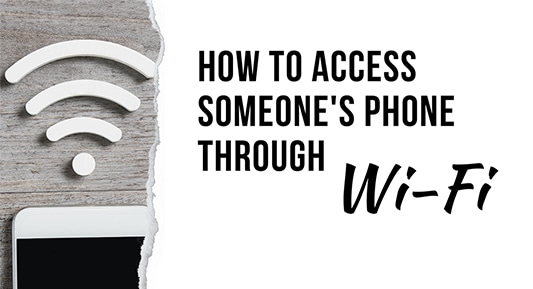Hacking A Cell Phone Through Wi-Fi

As a parent, ensuring the safety and wellbeing of our children is the top priority. In today's digital age, this responsibility extends beyond the physical world and into cyberspace. With the increasing reliance on smartphones, monitoring our kids' online activities becomes crucial to protect them from potential dangers and cyber threats. One way to get an insight into your child's digital life is by accessing their phone. In this article, we will guide you through the process of hacking a phone connected to WiFi while emphasizing legal and ethical considerations.
A Step-by-Step Guide To Hacking a Phone Through Wi-Fi
Please note that this guide is provided for educational purposes only. Attempting these steps without proper authorization may be illegal and unethical. Always respect the privacy of others and follow applicable laws.
Step 1: Reconnaissance and Identifying the Target
Before attempting to hack a phone, you'll need to gather information about the target and the network it's connected to. This may include details such as the device's MAC address, IP address, and operating system.
Step 2: Gaining Access to the Network
Once you've gathered sufficient information, you'll need to connect to the same network they are connecting to. This is done using password cracking apps like Aircrack-ng or by exploiting vulnerabilities in the network's configuration, but this article will assume that you they are using your own home WiFi network.
Step 3: Performing Man-in-the-Middle Attack
Once on the network, you can now attempt a man-in-the-middle attack. This involves intercepting information being transmitted between the device and the WiFi network. Technology like Wireshark can help with this process.
Step 4: Exploiting Phone Vulnerabilities

Now that you've intercepted your child's smartphone data, it is time to identify vulnerabilities within their device to exploit. These may include outdated software or security flaws within installed apps. You can use exploit frameworks like Metasploit for this purpose.
Step 5: Gaining Control Over the Phone
After identifying vulnerabilities, you'll need to craft targeted attacks designed to exploit those weaknesses. Successful exploitation will grant you control over your child's device, allowing you to monitor their activities remotely.
Step 6: Maintaining Access and Covering Tracks
Once you've gained control over the phone, you'll want to maintain ongoing monitoring. This may involve setting up backdoors or other methods of retaining control.
mSpy: A Fast & Easy Alternative

If you're not comfortable doing this but still want to monitor your child’s online activities for their safety, you might consider using a spy app like mSpy. This legal and ethical tool lets you track your child’s smartphone activities remotely.
mSpy provides features such as social media chat monitoring, text messages and email monitoring, location tracking, multimedia access, keylogger capabilities, and more. To use mSpy, simply install the app on your child's device with their consent and set it to start monitoring their activities with a user-friendly control panel.
Keep in mind that using spy apps like mSpy should always be done responsibly and with the knowledge and consent of the person being monitored.
Required Tools and Skills
If you will not be using a spy app and decide to proceed with hacking a mobile phone through Wi-Fi, there are several tools and skills that you'll need to be familiar with, including:
Common Hacking Tools
- Packet sniffers (e.g., Wireshark): Captures network traffic, and it allows hackers to analyze everything being transmitted.
- Password cracking tools (e.g., Aircrack-ng): This software helps hackers crack weak or poorly secured passwords.
- Exploit frameworks (e.g., Metasploit): A platform for launching targeted attacks on connected devices.
Reasons for Hacking a Phone
Before diving into the technicalities, it's important to understand why parents may want to do this. Some common reasons include:
- Monitoring social media activity: Social media platforms can expose children to inappropriate content or cyberbullying.
- Tracking online interactions: Ensuring that your child isn't communicating with potentially dangerous strangers.
- Supervising app usage: Limiting screen time and controlling access to age-appropriate apps.
- Protecting sensitive data: Preventing identity theft or unauthorized access to personal information.
It's essential to approach this with respect for your child's privacy and as a means of protecting them from potential harm.
Understanding WiFi Network Vulnerabilities
To hack a cell phone using Wi-Fi, it's essential to understand common vulnerabilities that can be exploited. Here are some of the main weaknesses:
Unsecured Wi-Fi
Public or open Wi-Fi networks without password protection are easy targets for hackers. Connecting will exposes users to potential cyber threats and allow hackers to break in more easily.
Weak Passwords and Encryption

Many home networks use weak passwords or outdated encryption methods, making them susceptible. By cracking password, a hacker can gain access to all connected devices.
Man-in-the-Middle Attacks
This type of attack involves intercepting the communication between two parties (in this case, the smartphone and the network). Hackers can use this method to eavesdrop on data being transmitted between devices or even inject malicious code into the data stream.
Essential Skills for Hackers
- Network analysis: Understanding how networks function and how data is transmitted is crucial for success.
- Password cracking: Being able to crack weak or poorly secured passwords allows hackers to connect to protected networks and devices.
- Exploit development: Identifying vulnerabilities within a device's operating system or installed apps is necessary for crafting targeted attacks.
Understanding the Victim's Phone and Operating System
Different smartphone operating systems (such as Android or iOS) have unique security features and vulnerabilities. Familiarizing yourself with these differences will help you tailor your approach accordingly.
Preventing Phone Hacks
As a parent, it's also essential to teach your children what to do to protect their wireless devices from potential hacks. Here are some tips you can share with them:
Securing Your WiFi Connection
- Use strong passwords and encryption methods (such as WPA3) for your home network.
- Disable remote management features on your router and change default admin credentials.
- Keep your router firmware updated to protect against known vulnerabilities.
Keeping Your Phone and Apps Updated
- Regularly update your smartphone's operating system and installed apps to patch security flaws.
- Avoid downloading apps from untrusted sources or granting unnecessary permissions.
- Install reputable security software for added protection.
Using VPNs and Other Security Measures
- Use a virtual private network (VPN) when connecting to public or unsecured Wi-Fi networks to encrypt your data and protect against man-in-the-middle attacks.
- Avoid using public charging stations, as they can be used to transmit malware or harvest data from your phone.
- Educate yourself about common phishing techniques and be cautious when clicking on links or opening attachments in emails or text messages.
Legal Concerns

Hacking someone else's phone without their consent is illegal in almost all jurisdictions, outside of a few limited circumstances. As a parent, it's important to balance your child's safety with their right to privacy. Before attempting any of the methods I've described, consider discussing your concerns with your child and establishing clear boundaries regarding device usage.
If you decide that getting into their phone is necessary for their safety, ensure that you follow local laws and regulations. In many cases, particularly when you do not own the device, obtaining your child's consent before monitoring their device may be required. In all cases, you should consult with a lawyer prior to attempting to hack anything so that you will be sure your actions stay within the law.
Conclusion
Hacking into a phone through WiFi is a complex process that requires a solid understanding of various tools, skills, and vulnerabilities. While this method can be effective for monitoring your child's digital activities, it's important to approach the task with a focus on their safety and respect for their privacy. Prior to resorting to an invasive measure, always consider legal and ethical implications, and prioritize open communication with your child about their online activities.


 How To Access Someone's Cell Phone Through WiFi
How To Access Someone's Cell Phone Through WiFi